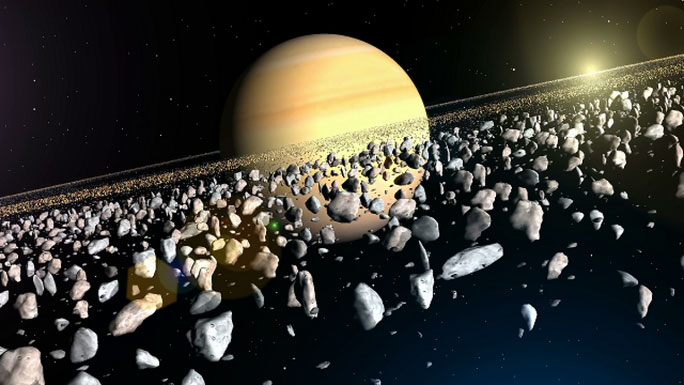Two Saturn moons crashed into each other and broke apart, creating a mystery?
One of the most puzzling structures in the Solar System may have been created by a collision of two icy moons orbiting Saturn.
A study recently published in the scientific journal The Astrophysical Journal suggests that in the "recent astronomical past ," two of Saturn's moons collided and created the characteristic rings around the planet.

Saturn's rings are a dense debris field - (Photo: UNIVERSE TODAY)
"It would be great to know if dinosaurs had good enough telescopes," quipped Dr. Jacob Kegerreis from NASA's Ames Research Center.
This implies that the catastrophic collision of the two moons could have occurred during the time of the dinosaurs, since according to NASA's previous calculations, Saturn's "young" ring system is only a few hundred million years old.
That time may be very distant to humans, but it is still "recent" in astronomical history and the age of the planet - more than 4.5 billion years old.
According to the New York Times, new research suggests that Saturn may have had more moons than the 145 currently confirmed , some of which were destroyed by collisions.
Given their moderate sizes, the two icy moons would be enough to release a lot of cold material toward Saturn.
If that ice crosses and remains behind the Roche limit — the boundary at which a planet's tidal gravity can disintegrate moons — it has a chance of turning into rings.
Other fragments may have collided with other moons, breaking up the "victims" a little as well, releasing more material.
This material could fill the rings, or it could clump together to form new moons.
This may explain the youth of Rhea, Saturn's second-largest moon after Titan.

Saturn's moon Rhea may also be the result of a collision of two moons several hundred million years ago, which set off a chain of collisions - (Photo: NASA)
Observations by NASA's Cassini spacecraft show that Rhea has a flat, circular orbit, suggesting it was formed only recently, possibly from debris from older moons.
That is also the reason why scientists search for life on Titan or Enceladus - the "old" moons - but not Rhea even though it is very large, because a world that is too "young" will hardly have enough time for the reactions that create life to complete.
- Discovered 20 new moons of Saturn
- NASA wants to send the transforming robot to explore Saturn's moons
- Cassini spacecraft said the latest information
- NASA announces panoramic picture of Saturn
- Discovering more activity on the two moons of Saturn
- How does Saturn's moon stripe form?
- Overview of Saturn
- Detecting water on Saturn moon
- Video: The last image of Cassini ship to Earth just before death
- The best picture of Saturn's UFO-like satellite
- The mystery of Saturn's rings and the terrible truth behind
- Unseen images of Saturn's belt
 Van Allen's belt and evidence that the Apollo 11 mission to the Moon was myth
Van Allen's belt and evidence that the Apollo 11 mission to the Moon was myth The levels of civilization in the universe (Kardashev scale)
The levels of civilization in the universe (Kardashev scale) Today Mars, the sun and the Earth are aligned
Today Mars, the sun and the Earth are aligned The Amazon owner announced a secret plan to build a space base for thousands of people
The Amazon owner announced a secret plan to build a space base for thousands of people